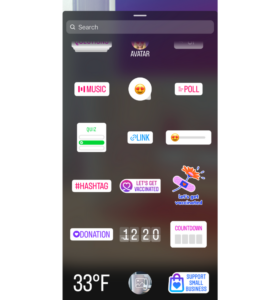If you think back far enough, you remember the days when Instagram was a casual photo diary. People would flood their profiles with multiple posts a day, users’ feeds would be filled with heavily filtered duck face selfies, their OOTD (outfit of the day), the perfect slice of avocado toast, and artsy outdoor flicks. Shocking right? In 2023 such a practice would be deemed taboo unless you’re a mega influencer of course. Somewhere along the way Instagram became carefully curated for people to build a meticulous visual identity. Photos are planned, posed, and edited to perfection. While Instagram was a driver in creating influencers and promoting their picture-perfect feed, users turned to other platforms, like Snapchat, for a more casual “behind the scenes” view of their friends’ lives.

But imitation is the greatest form of flattery, right? In 2016 Instagram attempted to regain the interest of Snapchat users with the bold decision to add Instagram Stories to their platform. Boom, death to the post. Well, not exactly, but this new feature altered the way users interacted with Instagram. Instagram Stories drove significant shifts in user behavior. From how influencers and businesses present themselves on the app, to how other social media platforms began to support the demand of short-form, casual content.

How are stories different and more effective than posts?
Posts serve as a backbone to your Instagram profile, being permanent curated capsules of how you are perceived by anyone who stumbles on to your content, including non-followers. Whereas, stories serve as short-formcontent that breaks the 4th wall, so to speak. They feel raw and impromptu as people speak straight to their followers. Stories also do a great job at creating a sense of urgency, users feel the need to check in throughout the day so they don’t miss out on any content before it disappears.
How do stories garner strong engagement?
Instagram Stories attract more than 400 million daily users, transforming the way people share and consume social media. Instagram Stories became a more casual and authentic way of sharing content with followers. Stories are temporary and disappear after 24 hours. The fleeting nature of stories makes the content feel more spontaneous and realistic. Stories are far less edited and often quickly filmed on the fly, feeling much more like an off-the-cuff one-to-one message than an artfully curated photoshoot result meant for the masses. Users can engage in stories in a multitude of ways, through face filters, polls, links/CTA buttons, replies, and likes. This enables stories to garner greater engagement, especially when trying to connect with new followers.

The story model produced great success, surpassing the views regular feed posts receive. Instagram stories build loyalty and a stronger connection with followers, enabling a platform to address them directly and provide an inside scoop on your life or your business. Stories are consistently watched to completion demonstrating just how powerful of a tool they are for capturing users’ attention.
What does this mean for my business?
62% of Instagram users say they have become more interested in a brand or product after seeing it in Stories. Instagram Stories can be a powerful tool for businesses to gain visibility and engagement with potential customers. Not to mention, stories can be a cost-effective way to keep up content velocity without significant effort in editing and post-production. The ability to layer text, GIFs, emojis, color filters, and much more is all built into the app interface enabling anyone to create polished professional-looking messages. Other platforms have also realized this creating things like Twitter Moments and YouTube Shorts, so story content is only going to continue to grow. If your business is looking to keep up with the best brand strategy firms, you need to tap into the power of stories and focus on curating short-form content that authentically connects with your followers.
If you are interested in learning more about how Bluetext’s marketing services can help you create quality content, contact us. As a DC-based digital design agency, we know how to make content that counts.
In today’s highly digital world, it’s no secret that each and every one of us is faced with an overload of content and information every day — but when it comes to marketing, does quantity really outweigh quality? The short answer is no. It can be easy to get caught up in the race to generate more: more content, more leads, more interactions. However, amidst this frenzy, a timeless principle continues to hold true — the undeniable value of quality over quantity. Shifting your focus towards producing quality content can lead to far more meaningful results. Not only will it drive engagement, but it will propel your brand towards sustained success.
Engagement that Resonates
With the integration of AI tools into marketing workflows, it is now easier than ever to roll out content at an accelerated rate. Companies are able to streamline the process of content creation and publish autonomously, but is the content that they’re creating truly resonating with audiences? Consistently producing content for content’s sake will not leave a lasting impression on an audience. Imagine sifting through a barrage of generic content that offers little more than a fleeting glance. Now contrast that with stumbling upon a meticulously crafted piece that speaks directly to your needs and interests — the latter, undoubtedly, captures viewers’ attentions and engages them on a deeper level. Quality content has the power to resonate with target audiences, evoking emotions, sparking conversations, and leaving lasting impressions. Forming genuine connections with your audience requires understanding their needs, engaging in meaningful conversations, and addressing their pain points — all of which needs to be done in a thoughtfully planned manner. By investing time in personalized interactions and addressing individual concerns, companies can foster a loyal community that actively supports and advocates for their brand.
Conversion that Counts
While a high quantity of leads might seem enticing, it’s the quality of those leads that matters. High-quality content has been found to generate 9.5 times more leads than low-quality content, and while having a steady presence on socials is important, it’s ultimately the number of conversions that result from your social presence that matters. Quality leads are more likely to become satisfied customers who stick around for the long haul; high-value content doesn’t just spark genuine and authentic interest amongst targeted audiences, but it can also establish lasting brand trust and loyalty. Long-term customers will inevitably drive consistent revenue and refer others to fall in line.
Brand Perception that Prevails
Your brand’s image is not just built by how frequently you appear, but by the impression you leave. A few high-quality interactions can create a stronger brand perception than a multitude of disengaged views. Consistently delivering value through quality content and interactions paints your brand in a positive light and encourages positive word-of-mouth referrals.
In the noisy landscape of modern marketing, the allure of quantity can be overwhelming, especially when AI tools can expedite content production and posting. However, by shifting your focus to quality, you’re not just participating in the marketing game — you’re setting yourself apart as a valuable player. Every piece of content, every interaction, and every engagement becomes a chance to make a meaningful impact. You are investing in the foundation of enduring success, building relationships that last and fostering a brand that stands the test of time.
If you are interested in learning more about how Bluetext’s marketing services can help you create quality content, contact us. As a dc-based digital design agency, we know how to make content that counts.
The number of podcast listeners has increased substantially since the global pandemic drove audiences indoors, seeking socially distanced entertainment. With this growing form of entertainment comes an increased opportunity for brands to spread the word about their products and services. It’s estimated that there will be over 100 million podcast listeners in the US by 2024, and 81% of these podcast listeners say they pay attention to the ads played during the podcast.
Why you should consider podcast advertising
The expanding audience of listeners isn’t the only reason for investing in this marketing channel. Podcasts are also especially lucrative because of their niche audiences, making potential customers easier to target within specific categories and demographics. Whether a company is trying to reach c-suite executives, technical experts, or federal decision-makers with their marketing, there’s a podcast out there for everybody. With such a large pool of podcasts to choose from, there are plenty of opportunities to reach specific target audiences.
What makes podcast ads so effective?
Podcasts have superior user engagement compared to traditional channels – 65% of users skip online video advertising on platforms like Youtube whereas only 33% of survey respondents say that they skip podcast ads (most of the time or always).
Why does podcast marketing have such high engagement? Unlike most marketing channels, podcasts have a well-established ground layer of trust between the host and listeners. This puts them at an advantage over other channels like display ads or video ads. In a way, this channel of marketing is tapping into the validation offered by celebrity endorsement, wherein the ‘celebrity’ is the host who viewers recognize and feel comfortable with.
How podcast ad buying works
Companies interested in buying podcast ad space can do so through Standard Advertising Agreements, where they pay to sponsor the podcast. In return, the host of the podcast will mention the sponsor’s product or services, describe their benefits, and sometimes even share personal anecdotes about the products or offer discounts and promo codes. See below for more information about the different factors to consider when buying podcast ads:
Pre-recorded or Host-read ads:
Ads can be pre-recorded and fully-produced by the brand itself or read by the host in their own words. Oftentimes, podcast hosts can offer specialized knowledge and expertise with their audiences to deliver the information about the sponsoring product or service in a way that best appeals to their listeners. Hosts are incentivized to make their podcast listening experience enjoyable, this includes smoothly incorporating ad interruptions in clever ways. For these reasons, host-voiced ads are more common.
Pre-roll, mid-roll, or post-roll ads:
The pre-roll ads and post-roll ads tend to be shorter (15-30 seconds long), and they play at the beginning of the show and at the end of the show, respectively. The longest of these are the mid-roll ads (30-90 seconds); their placement in the middle of the show is less skippable, so mid-roll ads usually come at a higher cost.
CPM (Cost-per-mile), CPA (Cost-per-acquisition), or flat rate ads:
CPM ads are most common, charging based on every per thousand listens of an episode. They typically run at a price of about $25 for 60 seconds. CPA ads are charged based on the number of conversions from the ad. Alternatively, a flat rate could be agreed upon beforehand, but this is much less common.
How to succeed with a podcast marketing initiative
With the increased exposure of podcast advertising, the best brand strategy firms are investing resources in exploring podcast-specific planning, buying, and measurement strategies. While a dedicated in-house podcast marketing division may not be feasible for many organizations, a digital marketing agency could offer the support and expertise you need to craft and deliver successful podcast advertising strategies.
Whether you’re at a small company that currently doesn’t do any podcast advertising at all, or you’re already buying some podcast ad placements, Bluetext can help to maximize the reach for your media spend with a strategic selection of ad opportunities. Contact us today to find out more about how we can help you build your brand and marketing strategies.
Launching your new or revitalized brand is the most important stage of the rebranding process. You’ve done all the hard work at this point, determining the right look and feel, message, and character for your brand. The crucial next step is to announce yourself to the world, both from an internal and external point of view. In today’s blog post, we’ll cover how to launch your new brand into the market and how to ensure your employees are ready to be your top brand ambassadors.
1. Brand Launches are Non-Linear in the Rebranding Process. Prepare Ahead of Time.
Preparation is the key to success. Without it, you run the risk of reducing the impact of your brand launch. You only get one shot at this so be sure to make the most of it. Begin ideating on how and when to launch your new brand at the start of your rebranding process. You’ll want to have a clear sense of the rationale behind the rebrand and how it impacts the broader narrative you want to communicate to the market. This foundation creates meaning and purpose, giving you a chance to engage with your existing customers and create new ones.
If you wait too long to start planning your brand launch, you risk confusing the market and your employees, leading to increased turnover and a decrease in market share. Be intentional and calculated as you determine the best course of action.
2. Increase Your Market Impact By Properly Determining Your Market
A successful brand launch reaches all notable audiences including both internal and external stakeholders. You’ll want to think strategically about your key audiences and prioritize your brand launch activities accordingly. For example, you may want to provide your high-value clients, key partners, and investors with a personalized introduction to your new brand. Making sure you create a positive trustworthy impression with your key audiences will increase the impact of your launch and the chance of success.
3. Communicate Efficiently, Communicate Effectively
The narrative you bring to the market for your brand launch is the most important aspect of the entire undertaking. Document your communication plan via a spreadsheet to ensure your tactics are on track from a timing and budget standpoint. Think through the most effective channels you can use to communicate the launch of your new brand to your key audiences.
Tactics can and should include: emails teasing the new brand, a pre-launch event for your most strategic audiences, and a landing page for people to visit to understand how the rebrand affects them in the short and long term. An effective communications strategy prepares your customers and investors for what’s to come and creates buzz around the new brand.
Think through a phased approach to your brand launch, utilizing a variety of tactics and channels to create the biggest impression. We’ve said it once and we’ll say it again: you only get one shot at this. Make it count.
When in partnership with Arlington Capital Partners, we launched Centauri. Our team developed and executed an integrated go-to-market strategy including PR, digital advertising, and social media. A key component of this campaign was a series of emails teasing the new logo, message, and brand into the market.

4. Saying Sayonara to Your Old Legacy Brand
While it may be hard to let go of the past and the brand assets that got you to this stage in your company’s lifecycle, you made the decision to rebrand and enter a new phase of growth. Migrating your brand from the old to the new creates consistency in your overarching brand narrative.
Create a brand migration list of all of the places your old brand is visible from both an internal and external view. Your website, building signage, virtual backgrounds, mugs, business cards, ad campaigns, etc. should all be added to the list of touchpoints. Determine what it will take to update each asset and work backward from the items that will take the longest to finalize. Ensuring each of these touchpoints is taken care of prior to your brand launch means minimizing confusion for your key audiences and the market at large.
5. The Key to a Successful Rebrand is Getting Your Internal Stakeholders Onboard
In many senses, your employees are your brand’s most important ambassadors. Getting them to embrace the changes and preach the narrative you’ve created with authenticity will ensure a smoother transition from the old to the new brand. Educate your staff on the brand’s mission, vision, and core values, articulating the direction of the new brand. Provide your employees with your updated brand guidelines, outlining how your brand should look in white papers, PowerPoints, data sheets, etc. Outfit your team in branded swag to make them feel like part of the team and drum up excitement ahead of the brand launch. Your people are your greatest asset; use them to their full potential and reap the benefits.
When ARKA came to Bluetext following a merger, they needed new messaging, brand creative, website design, and a brand launch program to unite the legacy companies. As part of the brand launch, our team implemented a full brand ambassador program, email announcements, a central inventory of brand assets, and FAQs. To get employees excited and geared with new brand creative, a ‘Welcome to the Brand’ kit was designed and coordinated to arrive with the announcement of the new logo & brand.
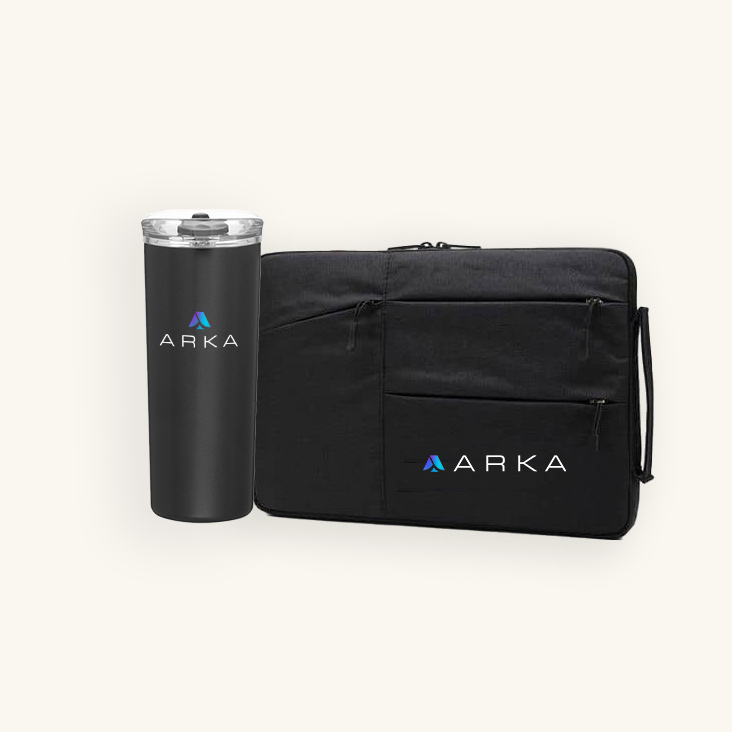
6. Launching Your Brand Externally – Patience is Key
The most important thing to remember for any external brand launch is to be patient. It’s an exciting time; pressure is high and the fruits of your labor over the last few months are about to be realized. Just remember, patience is required to achieve maximum impact, and timing is everything. Coordination is an integral component of your brand launch, ensuring everything launches without a hitch, and no one accidentally jumps the gun by updating their LinkedIn header with a graphic featuring your new logo. Using your brand migration list, execute accordingly, launching your new website, updating social media assets, and distributing press releases. Many brand launches culminate in a public event, where you unveil your new logo, mission, core values, etc.
Following a series of mergers and acquisitions, BigBear.ai came to Bluetext with the goal of creating a new unified brand identity, revamped external messaging, and strategic public relations that would help them stand out in the crowded AI space. As part of the external brand launch, our team designed a jaw-dropping trade show booth experience that brought the spirit of the BigBear.ai brand to life with a 3D video wall. It had event attendees stopping in their tracks.

7. Your Brand Launch is Just the Beginning
You did it! Your brand is officially in the market. While you may have thought this day would never come and it feels like you just crossed the finish line, remember that launching your brand is only the start of the journey. Keep tabs on all ongoing brand development and ensure that any new materials stay within your outlined brand guidelines. Consistency is king and has the power to make or break your new brand. Remember, a brand is a living, breathing organism that requires constant upkeep and preening. Conduct regular brand audits to ensure your brand is working for you and not the other way around.
Is your brand ready for a refresh? Contact us today at Bluetext to learn more about our rebranding services. We work with premier private equity companies, launching updated brands for newly merged or acquired companies into the market and generating massive successes.
In late 2021, Apple released its iOS 15 update with a pretty drastic change in browser layout, creating a ripple effect in website UX design. The beloved search bar on Safari had been moved from the top of the screen to the bottom. Many users, who are less familiar with the thought process behind UX design were left with one question. Why?
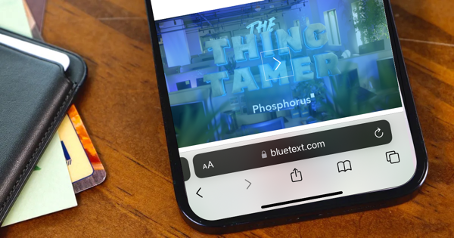
Well, according to MacRumors, the move was more functional than aesthetic. Think about how one naturally holds and operates a smartphone; usually held within the palm of the hand and touchscreen controlled by your thumbs from the bottom corners. Therefore, controls brought to the bottom of the screen are easier to reach with one hand. This feature also creates more space for users to focus on the webpage’s content.
Research confirms that “75% of users touch the screen with one thumb.” This has led UX designers to favor a thumb-driven design, placing the most important and frequently-used features at the bottom of the screen. This ensures easy access with one thumb.
Traditionally, many website designers place navigation in the top corners of the screen. While that works with a desktop device, due to the greater range of motion coming from the computer’s mouse, it does not translate that effectively to a mobile device. With the navigation menu being placed on the top corners of the screen, the range of motion that the user’s thumb has can restrict easy access to that navigation menu. Especially as technology evolves and mobile screens grow in size, users find themselves having to reposition their hands. This in turn slows down the user’s ability to navigate webpages and ingest content.
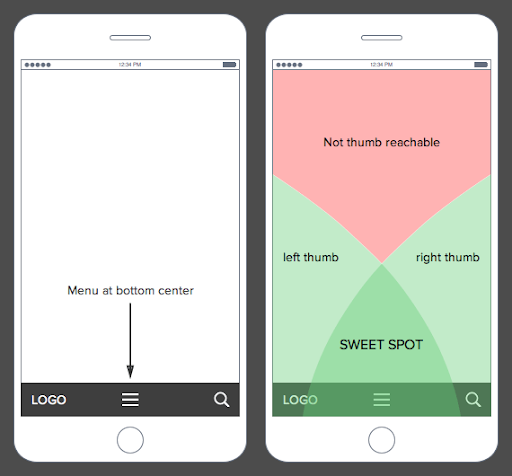
What’s the big deal? I just have to move my hand a little to be able to reach the top corner of my screen. The answer is simple: efficiency. Bottom menu navigation allows the user to accomplish tasks faster and with a greater level of comfortability, which really adds up considering that the average American spends 5.4 hours on their phones.

A lot goes into the design process, and it is not all about aesthetics. It’s about how the product functions. In today’s world, 55% of website traffic is generated using mobile devices, so functional and efficient mobile layouts for a website is imperative to the success of a brand. It is essential that UX designs make easy navigation a priority because the easier a product is to use the more often it will get used or recommended. That is why features like bottom navigation are so effective. Especially if it is designed in a streamlined way that makes content visible, clear, and simple.
As users experience the bottom menu trend, users will likely have to take some time to readjust. Looking ahead at UX design trends for 2022, there will be a continuation of the emphasis on overall usability, navigation, and aesthetics being driving forces for design. There is a desire to achieve a seamless experience, where user experience designers focus on the continuity and natural progression of connecting all the steps of finding a landing page to purchasing an item. It is imperative that functionality is favored, so it will be interesting to see more experimentation with navigation placement and overall screen flow on mobile devices in the future.
Does your website menu need a refresh? Contact Bluetext today to learn about our web and UX design services.
A Google search of “cyber security companies” will return well over 700 million results. As a business becomes increasingly digital and transitions more operations into cloud-based tools, the data of both the business and its customers become increasingly vulnerable to cyber attacks. Cyber security companies are cropping up in response to growing demand across industries, but even the cyber security companies have to worry about protection, especially when it comes to their websites. As its digital storefront, any website is a critical place to ensure proper security measures are in place.
Here are the top five steps that cyber security companies themselves are taking to keep their websites protected.
1. Ensure CMS Security
The most cost-efficient way to build and manage a website is to leverage a popular content management system, but on their own these systems are often prone to attacks. To mitigate vulnerability, cyber security companies install a series of security plugins or modules, such as Securi for WordPress and Security Kit or Paranoia for Drupal.
Important Note: Simple installing the plugin or module is not sufficient. To protect your website and its data, webmasters must update and configure new releases in a timely manner. Website design and development agencies, such as Bluetext, can ensure your site security is always up to date.
When Bluetext partnered with ManTech to completely redesign their website, CMS security was a major concern. ManTech is a multi-billion-dollar public company that provides subcontracted technological services to the US Government. We outfitted their new Drupal website with the latest and greatest security plugins to ensure adequate CMS security.

2. Leverage Two-Factor Authentication
The content management system supporting a website needs to be easy-to-use, but not easy-to-access. Top cyber security companies (and the cyber security marketing firms who design and build their sites) ensure that only entrusted individuals can manage content on their sites by implementing two-factor authentication. When a content editor attempts to login in to update a page, they must validate their identity through a secondary step, such as a text message, phone call, or email. We often recommend Duo from Cisco, which integrates easily with most content management systems.
When CyberArk, a Goldman Sachs-backed, global cybersecurity technology company turned to Bluetext to redesign its brand comprehensively, we also launched a new responsive digital platform, complete with two-factor authentication. The new website addressed the needs of CyberArk’s global enterprise customer base.

3. Setup (BIG) Form Security
Web forms are valuable tools to digital marketers — and hackers! The potential for attacks initiated via a web form is BIG, hence they need big security. Cyber security companies, like many other industries, use web forms as a key lead-generation tool, but they know these forms are not something to be taken lightly. Any element on your site that allows for (and actively seeks) user input is susceptible to SQL injections or spam bots. (The tl;dr for those links: you do not want your website to suffer either fate.) The key IT stakeholder for any website should make form security a top priority, and work with the website development agency to select and implement the right technical measures.
When Finite State, an IoT-based cybersecurity company, came to Bluetext to expand its industry presence through a full website development and rebrand, we made sure that form security was paramount to the fully customized WordPress content management system platform.
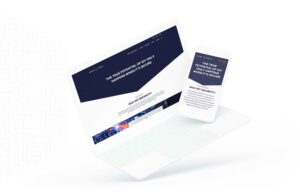
4. Don’t Skimp on Hosting
While GoDaddy allows a company to save money, cyber security companies know that those savings come at an even higher cost in terms of security vulnerabilities. Though secure hosting providers come with a higher monthly bill, the long-term peace of mind in security far outweighs the short-term costs. These providers offer SSL certificates, CDNs, firewalls and more to ensure that websites can withstand malicious malware and attacks. Some of the top secure hosting providers recommended by top website development agencies include WP Engine and HostPapa.
Hosting security was top of mind for our client, PlanetRisk. When PlanetRisk, an enterprise risk analytics company, hired Bluetext to lead a comprehensive rebrand and new digital user experience and re-platform their content management system, we made sure that their updated website was fully secure, hosting-wise.
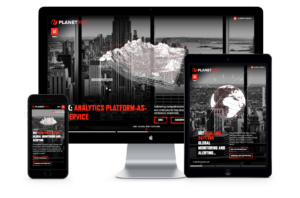
5. Take a Proactive Stance
Too often, website security measures are only implemented as a reactionary step following an attack. Cyber security companies know better. If a malicious attacker penetrates the website, they could irreversibly tarnish the brand. Cyber security companies make sure that the steps above are covered before an attack by configuring them before the website launches. Proactive protection can be a challenge if you don’t know what to expect, so be sure to consult an experienced website development agency to ensure your bases are covered with the most up to date security measures.
If you model your website security initiatives after the experts, you’ll be best set up to withstand attacks. Learn from the experience of a cyber security marketing agency—don’t skip these important steps!

